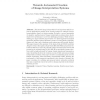Free Online Productivity Tools
i2Speak
i2Symbol
i2OCR
iTex2Img
iWeb2Print
iWeb2Shot
i2Type
iPdf2Split
iPdf2Merge
i2Bopomofo
i2Arabic
i2Style
i2Image
i2PDF
iLatex2Rtf
Sci2ools
AUSAI
2003
Springer
2003
Springer
Towards Automated Creation of Image Interpretation Systems
Abstract. Automated image interpretation is an important task in numerous applications ranging from security systems to natural resource inventorization based on remote-sensing. Recently, a second generation of adaptive machine-learned image interpretation systems have shown expert-level performance in several challenging domains. While demonstrating an unprecedented improvement over hand-engineered and first generation machine-learned systems in terms of cross-domain portability, design-cycle time, and robustness, such systems are still severely limited. This paper inspects the anatomy of the state-of-the-art Multi resolution Adaptive Object Recognition framework (MR ADORE) and presents extensions that aim at removing the last vestiges of human intervention still present in the original design of ADORE. More specifically, feature selection is still a task performed by human domain experts and represents a major stumbling block in the creation process of fully autonomous image interp...
Artificial Intelligence | AUSAI 2003 | Image Interpretation | Image Interpretation Systems | Machine-learned Image Interpretation |
| Added | 06 Jul 2010 |
| Updated | 06 Jul 2010 |
| Type | Conference |
| Year | 2003 |
| Where | AUSAI |
| Authors | Ilya Levner, Vadim Bulitko, Lihong Li, Greg Lee, Russell Greiner |
Comments (0)

